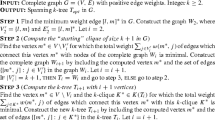Abstract
An algorithm is presented for the problem of sizing link capacities in an alternate routing telecommunications network with time-varying demands. Several algorithms have been developed since 1977 for this problem, where costs are linear and the existing network is ignored. We consider the case of per-trunk (communications channel) costs for adding and disconnecting trunks from an existing network, and fixed costs for the first trunk added or disconnected on each link. A branch and bound procedure is developed to solve the problem. Lower bounds in the search tree are obtained through the use of Lagrangian relaxation and subgradient optimization. Several tests are employed to detect infeasibility of subproblems generated in the tree search. Computational results are presented, including comparisons of results using different tolerances for pruning the search tree.
Similar content being viewed by others
References
G.R. Ash, R.H. Cardwell and R.P. Murray, Design and optimization of networks with dynamic routing, Bell Syst. Tech. J. 60(1981)1787–1820.
G.R. Ash, J.-S. Chen, A.E. Frey and B.D. Huang, Real-time network routing in a dynamic class-of-service network, in:Teletraffic and Datatraffic in a Period of Change, ITC-13, eds. A. Jensen and V.B. Iversen (North-Holland, Amsterdam, 1991).
P.A. Caballero and F. Diaz, Optimization of networks with hierarchical structure with non-coincident busy hours,Proc. 7th Int. Teletraffic Congress, Stockholm, 1973, p. 421.
W.H. Cameron, J. Regnier, P. Galloy and A.M. Savoie, Dynamic routing for intercity telephone networks,Int. Teletraffic Conf. 10, Montreal, 1983, Paper 3.2–3.
F. Caron, Results of the Telecom Canada high performance routing trial,Int. Teletraffic Conf. 12, Torino, 1988, Paper 2.2A.2.
M. Eisenberg, Engineering traffic networks for more than one busy hour, Bell Syst. Tech. J. 56(1977)1–20.
W.B. Elsner, A descent algorithm for the multihour sizing of traffic networks, Bell Syst. Tech. J. 56(1977)1405–1430.
M.L. Fisher, The Lagrangian relaxation method for solving integer programming problems, Manag. Sci. 27(1981)1–18.
A.M. Geoffrion and R.E. Marsten, Integer programming algorithms: A framework and state-of-the-art survey, Manag. Sci. 18(1972)465–491.
R.J. Gibbens, F.P. Kelly and P.B. Key, Dynamic alternate routing — modelling and behavior,Int. Teletraffic Conf. 12, Torino, 1988, Paper 3.4A.3.
A. Girard,Routing and Dimensioning in Circuit-Switched Networks (Addison-Wesley, New York, 1990).
A. Girard, P.D. Lansard and B. Liau, A multi-hour ECCS theory and applications,Proc. 3rd Int. Network Planning Symp., Tarpon Springs, Florida, 1986, pp. 78–84.
A. Girard, P.D. Lansard, B. Liau, A.M. Mongeon and J.L. Thibault, Multihour engineering and traffic routing optimization in hierarchical telephone networks, Ann. Telecommun. 46(1991)335–350.
J.L. Goffin, On convergence rates of subgradient optimization methods, Math. Progr. 13(1977)329–347.
W.S. Hayward and J.P. Moreland, Total network data system: Theoretical and engineering foundations, Bell Syst. Tech. J. 62(1983)2183–2207.
I. Hedberg, Optimization of alternate routing networks with regard to existing equipment and modularities,Int. Teletraffic Conf. 10, Montreal, 1983, Session 4.3A.
M. Held, P. Wolfe and H. Crowder, Validation of subgradient optimization, Math. Progr. 6(1974)62–88.
D.L. Jagerman, Methods in traffic calculations, AT&T Bell Lab. Tech. J. 63(1984)1283–1310.
F.P. Kelly, Routing in circuit switched networks: Optimization, shadow prices, and decentralization, Adv. Appl. Prob. 20(1988)112–144.
K.O. Kortanek, D.L. Lee and G.G. Polak, A linear programming model for design of communications networks with time varying probabilistic demands, Naval Res. Logist. Quart. 28(1981)1–32.
E.J. Messerli, Proof of a convexity property of the Erlang-B formula, Bell Syst. Tech. J. 51(1982)951–953.
R.F. Rey (ed.),Engineering and Optimization in the Bell system (AT&T Bell Lab., Murray Hill, NJ, 1983).
R.T. Rockafellar,Convex Analysis (Princeton University Press, Princeton, NJ, 1970).
E. Rosenberg, A nonlinear programming heuristic for computing optimal link capacities in a multihour alternate routing communications network, Oper. Res. 35(1987)354–364.
G. Sallai and Z. Dely, Modular engineering and full grouping theorems for alternate routing networks,Int. Teletraffic Conf. 10, Montreal, 1983, Session 4.3B.
C.J. Truitt, Traffic engineering techniques for determining trunk requirements in alternate routing trunk networks, Bell Syst. Tech. J. 33(1954)277–302.
Author information
Authors and Affiliations
Rights and permissions
About this article
Cite this article
Rosenberg, E. Designing multi-hour hierarchical communications networks with fixed charge and piecewise linear costs. Telecommunication Systems 3, 109–128 (1994). https://doi.org/10.1007/BF02110139
Received:
Accepted:
Issue Date:
DOI: https://doi.org/10.1007/BF02110139




